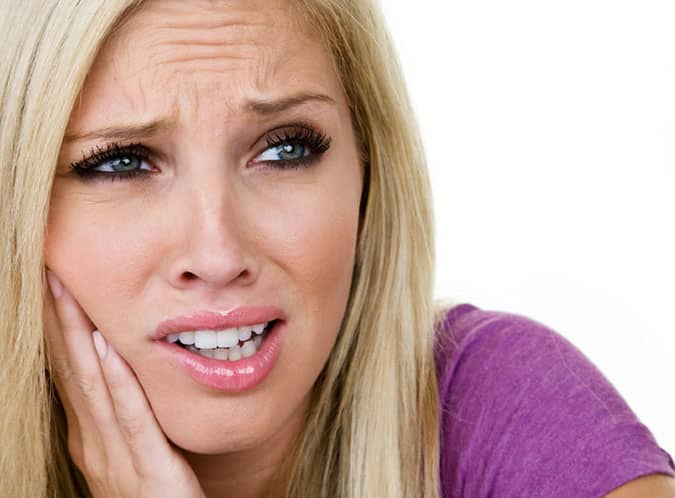
Pain in the Cheek
Pain in the cheek and cheek pain can be painful and also cause side effects such as headaches. Pain in the cheek can be due to jaw joint locking, muscle tension (including masticatory muscle myalgia), dental problems and injury.
Some of the most common causes are dysfunction of the jaw muscles and jaw joint, often called TMJ (temporomandibular) syndrome, it can also be due to trauma - which in turn can lead to jaw injury or meniscus irritation. In the case of major trauma, jawbone fractures or fractures of the face may also occur. Gum problems, poor dental hygiene, nerve problems, sinusitis, and infection are also conditions that can cause pain in the cheek. More rare causes can be acoustic neuroma, Fibromyalgia or polymyalgia rheumatism. Another very rare cause of pain in the cheek and oral cavity is cancer. Jaw tension can also be caused or worsened by malfunction of the neck og shoulder.
Where and what is the cheek?
The chin is the part of the face that makes up the area below the eyes, inside the nose and between the left and right ear.
Also read:
- Complete overview of muscle knots and their reference pain pattern
- Pain in the muscles? This is why!
Kinnets anatomy
Image: In the picture we see some of the most important muscular causes of pain in the cheek. Overexertion in the large masticatory muscle and the inner jaw muscles are called, respectively masseter myalgia and pterygoid myalgia. Myalgia simply indicates muscular dysfunction or muscular tension. Tight jaw muscles can also help or aggravate headache.
What is pain?
Pain is the body's way of saying that you have injured yourself or are about to hurt you. This is an indication that you are doing something wrong. Not listening to the body's pain signals is really asking for trouble, as this is its only way to communicate that something is wrong. This applies to pain and aches all over the body, not just back pain as so many people think. If you do not take the pain signals seriously, it can lead to long-term problems, and you risk the pain becoming chronic. Naturally, there is a difference between tenderness and pain - most of us can tell the difference between the two.
When the pain is attenuated, it is necessary to weed out the cause of the problem.

Some common causes / diagnoses of cheek pain are:
Poor dental health - cavities or gum disease
Mild infection
Mouth ulcers (can be caused by slight injury, irritation, Herpes zoster, reduced immune system and a host of other conditions)
Referred pain from the jaw and jaw muscles (i.a. masseter (gum) myalgia may cause referred pain or 'pressure' against mouth / cheek)
TMJ syndrome (temporomandibular syndrome - often composed of muscle and joint dysfunction)
Trauma (biting, irritation, burns and the like)
Rare causes of pain in the cheek:
Fibromyalgia
Herpes labialis (Herpes outbreaks on or in the lips)
Infection (often with high CRP and fever)
Cancer
Lupus
Nervous pain (including trigeminal neuralgia)
Polymyalgia rheumatism
Trigeminal neuralgia
Make sure you do not go with a sore cheek for a long time, rather consult a clinician and diagnose the cause of the pain - this way you will make the necessary changes as early as possible before it has a chance to develop further.
Reported symptoms and pain presentations of pain in the cheek:
- Electrical pain in the cheek (may indicate nerve irritation)
- Itching in the cheek
Numbness in the cheek
- Stinging in the cheek
- Pain in the cheek (a pain or burning sensation in parts or the whole cheek)
- Sores on the cheek (wounds in parts or the whole cheek)
- Sore cheek
- Sore jaw (do you have muscle or joint pain in the cheek or jaw joint?)
Clinical signs of sore cheek and cheek pain
Swelling can occur around a trauma or through an infection.
- Pressure tenderness over the jaw joint can indicate defects in muscular or joint function.
How to prevent pain in the cheek
- Live healthy and exercise regularly
- Seek well-being and avoid stress in everyday life - try to have a good sleep rhythm
- Make sure you have good oral hygiene
- chiropractor og manual therapists can both help you with joint and muscle pain in the jaw
Did you know: Jaw complaints and jaw tensions can also, like malfunction of the muscles and joints of the neck, contribute to headaches.
Conservative treatment of sore cheek
home Practice is often printed and used to address improper use of musculature, with the intention of providing a long-term, long-lasting effect. Ultrasound can be used both diagnostically and as ultrasound therapy, the latter works by providing a deep-warming effect aimed at musculoskeletal problems. Joint Mobilization or corrective chiropractic joint treatment increases the movement of the joints, which in turn allows the muscles that attach to and near the joints to move more freely. Chiropractic joint therapy is often combined with muscle work in the treatment of TMJ syndrome and jaw tension.

Massage It is used to increase blood circulation in the area and thus reduce muscular tension, which in turn can cause less pain. heat treatment used to give a deep-warming effect on the area in question, which in turn can give a pain-reducing effect - but it is generally said that heat treatment should not be applied to acute injuries, as is ice treatment to prefer. The latter is used for acute injuries and pains to help ease the pain in the area. laser treatment (also known as anti-inflammatory laser) can be used at different frequencies and thus achieve different treatment effects. It is often used to stimulate regeneration and soft tissue healing, plus it can also be used anti-inflammatory.
List of treatments (both much alternative and more conservative):
- acupressure
- Acupuncture
- aromatherapy
- behavioral therapy
- Atlas Correction
- Ayurvedic medicine
- Bioelectromagnetic therapy
- blockade Treatment
- Soft tissue work
- Bowen Treatment
- Coxtherapy
- Electrotherapy
- Ergonomics
- Dietology
- Reflexology
- Physiotherapy
- gonstead
- Healing
- home Practice
- Homeopathy
- Hydrotherapy
- hypnotherapy
- Infrared light therapy
- insoles
- Intramuscular needle therapy
- Ice therapy
- remedy
- kinesiology
- Kinesiotape
- chiropractic
- Cognitive processing
- crystal Therapy
- contrast Treatment
- Cupping
- Cold Treatment
- Laser
- Joint Correction
- Joint Mobilization
- Medical treatment
- Lymphatic drainage
- Light Therapy
- magnet Treatment
- manual Therapy
- Meditation
- Muscle Relaxing Medications
- muscle Knute treatment
- Myofascial technique
- Naprapathy
- Naturopathy
- Neurological rehabilitation training
- qigong
- Osteopathy
- breathing
- reflexology
- Shockwave Therapy
- Pain medication
- Spinology
- Sports support
- Stretch bench
- Power Management
- sole Customization
- Thought Field Therapy
- TENS
- Thai Massage
- Traction
- Exercise
- Trigger point therapy
- Shockwave Therapy
- Dry needle
- stretching
- Vacuum Treatment
- heat treatment
- Hot water therapy
- Yoga
- Exercises
Chiropractic treatment of jaw pain
The main goal of all chiropractic care is to reduce pain, promote overall health and improve quality of life by restoring normal functioning of the musculoskeletal system and nervous system. In case of jaw pain, the chiropractor will treat the jaw locally to reduce pain, reduce irritation and increase blood supply, as well as restore normal movement in nearby structures such as the neck, thoracic spine and shoulder. When choosing a treatment strategy for the individual patient, the chiropractor places emphasis on seeing the patient in a holistic context. If there is a suspicion that the jaw pain is due to another disease, you will be referred for further examination.
The chiropractor treatment consists of a number of treatment methods where the chiropractor mainly uses his hands to restore normal function of the joints, muscles, connective tissue and nervous system:
- Specific joint treatment
- Stretches
- Muscular techniques (many use both trigger point therapy and dry needling)
- Neurological techniques
- Stabilizing exercise
- Exercises, advice and guidance
What does a chiropractor do?
Muscle, joint and nerve pain: These are things that a chiropractor can help prevent and treat. Chiropractic treatment is mainly about restoring movement and joint function that can be impaired by mechanical pain.
This is done by so-called joint correction or manipulation techniques, as well as joint mobilization, stretching techniques, and muscular work (such as trigger point therapy and deep soft tissue work) on the involved muscles. With increased function and less pain, it may be easier for individuals to engage in physical activity, which in turn will have a positive effect on both energy and health.
Old woman's advice against pain in the jaw
We choose to bring some advice against the pain in the jaw. We have also tried to understand the meaning behind them and thus put a little explanation in brackets.
- Drink ginger tea (Ginger reduces muscle pain)
- Rest in the sun (The sun provides the basis for vitamin D. Vitamin D deficiency has been linked to increased muscle pain)
- red bell pepper powder (Red bell pepper has among the very highest content of vitamin C - needed for soft tissue repair)
- Eat blueberries (Blueberries have a pain-relieving and anti-inflammatory effect)
NEXT PAGE: - Pain in the seat? Do something about it!
Click on the image above to proceed to the next page.
References:
1. Images: Creative Commons 2.0, Wikimedia, WikiFoundry
Frequently asked questions about the pain in the cheek:
- No questions yet. Feel free to post one on our facebook page or via the comment field below, right?
Q: -
Reply: -
 Follow Vondt.net on YOUTUBE
Follow Vondt.net on YOUTUBE
(Follow and comment if you want us to make a video with specific exercises or elaborations for exactly YOUR issues)
 Follow Vondt.net on FACEBOOK
Follow Vondt.net on FACEBOOK
(We try to respond to all messages and questions within 24-48 hours. We can also help you interpret MRI responses and the like. Otherwise, please invite friends and family to like our Facebook page - which is regularly updated with good health tips, exercises and diagnostic explanations.)
Also read: - Rosa Himalayan salt's incredible health benefits
Also read: - Pain in the muscles? This is why!









Leave a reply
Want to join the discussion?Feel free to Contribute!